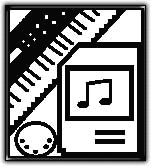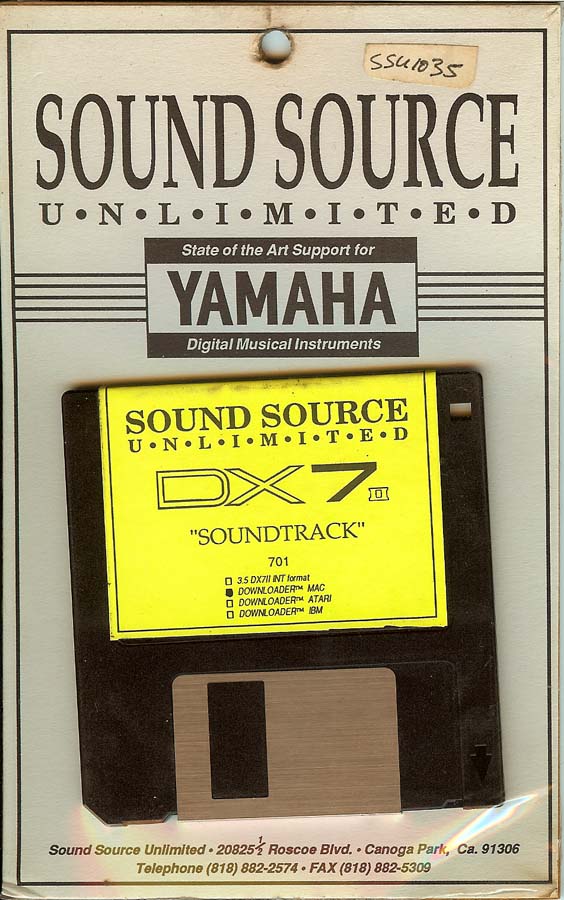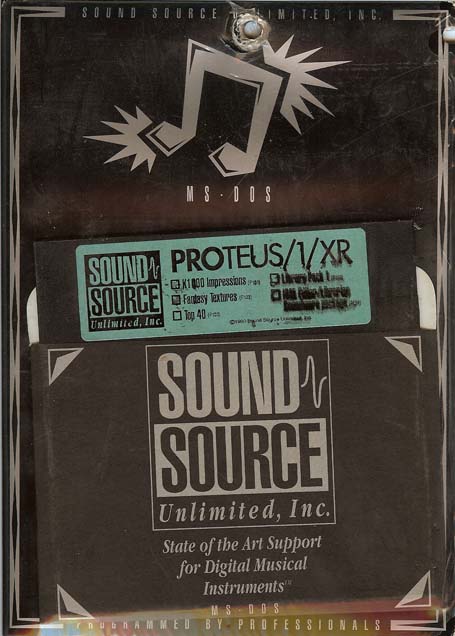This Ensoniq Mirage DSK-8 (second version) is from the original owner who used it only his smoke free studio. It's in excellent condition. Includes the sustain pedal (model FSW-1), the sequencer expander card (model SXQ-1) and the laminated Parameter Reference Card.
This Gray DSK-8 was the second-generation Mirage, in a metal case, with a dark gray paint job and a much-improved Fatar keybed. You can easily distinguish these Mirages by the smaller buttons - now gray, yellow, white, and black. Both versions of the DSK-8 sold for $1695, and included two sound disks, a sustain pedal, the Musician's Manual, the Advanced Sampler's Guide, the Formatting Disk, and a laminated Parameter Reference Card.
Back panel connections were mono Audio In and Out jacks, a Sync jack, MIDI In and Out/Thru conectors, a Foot Switch jack for the sustain pedal, and an expansion port on the back panel for either an ISF-1 Input Sampling Filter or the SQX-1 Sequencer Expander. The Sync jack on the back panel was intended to sync the Mirage's sequencer to an external clock source; since the sequencer is all but useless, the Sync jack and circuitry were dropped on the later DSK-1.
The Mirage was Ensoniq Corporation's first product, introduced in 1984. Priced below $1700 with features previously only found on more expensive samplers like the Fairlight CMI, it became a best-seller. The Mirage was the earliest affordable sampler-synths.
The Mirage was an 8-bit sampler featuring a 61 key velocity-sensitive keyboard, a two-digit LED display, extensive MIDI implementation, analog filters, and a 333-event sequencer. It had 128kB of RAM (64kB for each keyboard halve) and it was not expandable. Sample rate was variable from 10kHz to 33kHz with available sample time ranging from 2 to 6.5 seconds accordingly (for each keyboard halve).
It included a built-in 3.5 inch SS/DD floppy drive, which was used to boot the operating system as well as store samples and sequences. Each disk had a copy of the operating system and could be used as a boot disk, thus there was no need for a separate boot disk.
Each disk stored six samples and up to eight sequences. The keyboard was 'pre-configured' into two halves, each functioning as two independent instruments, though the split point could be moved. This made it easy to have one sound for the right hand (an 'upper' sound) and another for the left (a 'lower' sound). However, the standard OS could not move samples between keyboard halves. Thus the diskette could save three 'upper' sounds and three 'lower' sounds. Ensoniq later made an alternative OS available called MASOS which traded off performance features for editing features, including the ability to copy an 'upper' sound to a 'lower' sound and vice-versa.
Using a feature called multi-sampling, the Mirage was also capable of assigning multiple samples to different keys across its keyboard. Using this technique, the Mirage essentially turned into a polyphonic mult-timbral MIDI sound module complete with a velocity-sensitive keyboard that could be used to drive other MIDI sound modules as well its own sound engine. Its complex programming system which is based on hexadecimal coding made it difficult to program and record samples, however, a library of sounds became available for it so many users never had to learn to program it.
The Mirage sampler has become a sought-after item due to its low bitrate converters, behind ther Akai MPC60's and S900's. Tthere is a certain amount of nostalgia concerned with the Mirage, particularly with its sample library which still stands the test of time. It has been used by Skinny Puppy, Vangelis, Jimmy Edgar, and Jimmy Jam and Terry Lewis.
There were three versions of the Mirage. The first had a spongy feeling keyboard and large square black buttons. The second had a better-weighted feel keyboard and small calculator-like buttons. The third was shorter and in a plastic case, had a non-weighted keyboard and sold for about $1300 USD.
This product was added to our catalog on Wednesday 06 November, 2013.




